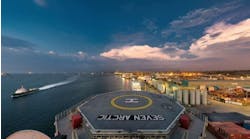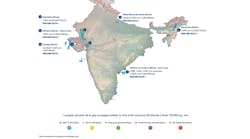Larry Forster
Thiago Mesquita Paes
Robert J. Baker
INTECSEA, Inc.
This issue ofOffshore contains the 2015 Worldwide Survey of Subsea Processing Systems poster, the eighth installment of this industry resource, a joint effort between INTECSEA and Offshore magazine. The primary aims of this poster are to chronicle the development, and the developers of these systems, and to document the continued commitment of oil companies to the application of these technologies on a global basis.
A user's guide
From its inception, the intent of the poster has been to serve as a guide for users of subsea processing technology, an initial entry point into the ever-increasing body of knowledge and experience in the industry. The poster typically presents a sampling of information available to the industry; the nomenclature and concepts of the poster have been utilized throughout industry as the basis for subsequent work.
New to the poster this year are specific references to the Technology Readiness Level (TRL) scale utilized in the soon-to-be-issued API RP 17N, Recommended Practice for Reliability, Technical Risk and Integrity Management. This recommended practice is already proving useful in developing technology road maps to facilitate rapid and consistent technology maturation and qualification. The team hopes to support the industry's use of this practice by adopting and promoting the common language in the technology management process.
A common pattern reflected in the poster is the continuing progress toward standardization and consistency in product and system offerings. This can be seen in the increased ratio of actual equipment versus conceptual systems. This year's poster illustrates that the modularity and overall packaging designs associated with subsea processing are now consistent with subsea trees, manifolds and other well-established subsea equipment items. Additional highlights for 2015 are described below.
Technology risk reduction
One of the key indications of progress in technology evolution is the inclusion of new technology into significant projects. Processing technologies that reach the proven prototype stage (TRL 4-5) are now a candidate for inclusion, or at least consideration, in deepwater projects. Further risk reduction and maturation of the technology is targeted within the active project execution cycle, and are increasingly synchronized with technology development timelines.
Perceived risk serves as the biggest obstacle to the use of subsea processing technology. Operators are hesitant to actively include these new technologies in projects (despite their numerous advantages) over traditional topsides and onshore processing. One way to reduce the perceived risk is by championing an increased understanding of these technologies and learning how to safely manage their risks, a further benefit of the work that has gone into API RP 17N. As further usage of the technology increases, the risks will decrease with experience.
Conservative approaches to technology inclusion have given way to increased willingness to embrace technology and its benefits.
The industry has recognized subsea electrical power systems as a key enabler for subsea processing systems for a number of years. The editors of this poster have worked each year to capture the key concepts for subsea power transmission and distribution in increasing water depths, and increasing distances from host facilities. Some of the concepts for very long step-out distances (~100 mi) still remain concepts only, with no installations planned for the near term. In 2014, operators and manufacturers have put specific emphasis on subsea power distribution for more moderate, yet significant step-out distances (~30 mi).
Projects now include boosting applications of sufficient size and distance from host facilities to warrant detailed evaluation of subsea distribution equipment, in contrast to an individual cable from topsides to each pump installed subsea. Further investigations into subsea power distribution will involve subsea variable speed drives, switchgears, as well as connectors and penetrators. There have been an increasing number of subsea electrical connectors and penetrators qualified for use, and many more beyond those shown on this year's poster are still in development.
Subsea gas compression
In previous years, subsea gas compression technology was noted as a long-term goal for subsea processing, and as something to watch for the future. In 2015, the future arrives with two firsts: the first subsea compression installation at Åsgard, and the first wet gas compression installation at Gullfaks. Each installation utilizes technologies from two different manufacturers, Aker Solutions and OneSubsea.
Seawater treatment
Water treatment and injection has been identified as an up and coming area of subsea processing. The possibility of a modular, self-contained system to condition raw seawater for pressure maintenance injection into reservoirs, such as the Seabox offering illustrated in the 2015 poster, is drawing the interest of the reservoir engineering community as an effective approach to waterflooding. As in the case of subsea power distribution, operators are beginning to consider detailed evaluation of technology for seawater treatment, as compared to the familiar, but potentially costly, topsides system alternatives.
Standardization
Each operator wants the best system they can get for their application. In some cases, operators will focus on individual component development with a given manufacturer and work to maximize capabilities as the answer for any application going forward. In other cases, operators speak about the importance of, and the critical need for, standardization among components across industry, as the way to ensure that the needed performance is available from a broad marketplace.
This concept of standardization implies the ability to mix and match among different manufacturers. It may also apply within the supply of a single manufacturer – the concept of building blocks from a particular catalog to efficiently tailor a system to the unique needs of a given application.
For online access to view and download all posters, please visitwww.offshore-mag.com/maps-posters.


